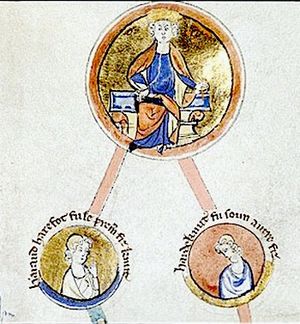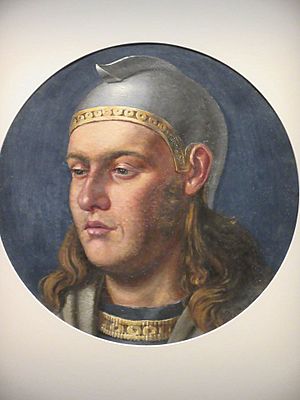Harthacnut facts for kids
Quick facts for kids Harthacnut |
|
|---|---|

Harthacnut in the 14th-century Genealogical Roll of the Kings of England
|
|
| King of Denmark | |
| Reign | 1035 – 8 June 1042 |
| Predecessor | Cnut the Great |
| Successor | Magnus the Good |
| King of the English | |
| Reign | 17 March 1040 – 8 June 1042 |
| Predecessor | Harold I |
| Successor | Edward the Confessor |
| Born | c. 1018 England |
| Died | 8 June 1042 (aged 23–24) Lambeth, England |
| House | Jelling |
| Father | Cnut the Great |
| Mother | Emma of Normandy |
Harthacnut (also known as Hardicanute or Canute III) was a powerful king who ruled both Denmark and England. He was King of Denmark from 1035 to 1042 and King of England from 1040 to 1042.
Harthacnut was the son of Cnut the Great, a very famous king who ruled Denmark, Norway, and England. His mother was Emma of Normandy. When his father Cnut died in 1035, Harthacnut faced challenges keeping all his father's lands. He became King of Denmark. He later became King of England in 1040 after his half-brother, Harold Harefoot, died. Harthacnut died suddenly in 1042. He was the last Danish king to rule England.
Contents
Early Life and Challenges
Harthacnut was born around 1018. His parents, King Cnut and Queen Emma, married in 1017. Cnut had promised that any sons he had with Emma would become kings before sons from his first marriage. This meant Harthacnut was seen as Cnut's main heir in England.
In the 1020s, Denmark was in danger from Norway and Sweden. To protect Denmark, Cnut sent eight-year-old Harthacnut there to be the future king. He was to rule with the help of his uncle, Ulf the Earl. However, Ulf upset Cnut by letting the Danish areas recognize Harthacnut as king without Cnut's full approval. Ulf also didn't act quickly enough against the invaders.
In 1027, Cnut arrived in Denmark with his fleet. He forgave Harthacnut because he was so young. But Cnut had Ulf murdered. Cnut then drove out the invaders and took control of Norway. He returned to England in 1028, leaving Harthacnut to rule Denmark.

Cnut had left Norway under the rule of Haakon Ericsson. But Haakon drowned in 1029 or 1030. Cnut then appointed his other son, Svein Knutsson, to rule Norway with Svein's mother, Ælfgifu. However, they were unpopular because of high taxes. When Magnus I of Norway invaded in 1035, Svein and Ælfgifu had to flee to Harthacnut's court. Harthacnut was a good friend to Svein. But he felt he didn't have enough power to invade Norway himself. The half-brothers hoped their father would help. Instead, they heard that Cnut had died in November 1035.
Becoming King
Ruling Denmark and England
After his father's death in 1035, Harthacnut became King of Denmark. He was called Cnut III. He couldn't go to England right away because of the situation in Denmark. So, it was agreed that his half-brother, Harold Harefoot, would rule England as a temporary king. Harthacnut's mother, Emma, would look after Wessex for Harthacnut.
By 1037, Harold was widely accepted as the true king of England. The Anglo-Saxon Chronicle said Harthacnut was "forsaken because he was too long in Denmark." Emma had to flee to Bruges in Flanders. In 1039, Harthacnut sailed with ten ships to meet his mother. He waited to invade England because Harold was very sick and soon died in March 1040. After Harold's death, messengers quickly came to Harthacnut, offering him the English throne.
Historians have different ideas about what happened after Cnut's death. It's not clear if Harthacnut was supposed to get England as well as Denmark. But coins made in southern England had his name on them, while northern coins had Harold's. This suggests there might have been a plan to divide the kingdom if Harthacnut had arrived sooner. He likely stayed in Denmark because of the threat from Magnus of Norway.
Harthacnut and Magnus eventually made a treaty. They agreed that if either king died without an heir, the other would inherit his kingdom. This agreement might have allowed Harthacnut to focus on claiming England.
Return to England
Harthacnut traveled to England with his mother. He landed peacefully at Sandwich, Kent on June 17, 1040. Even though he was invited to be king, he brought 62 warships. He wasn't taking any chances and came like a conqueror. He had to pay his ship crews for their service. To do this, he collected a huge tax of over 21,000 pounds. This made him very unpopular, even though it was less than what his father had collected in similar situations.
Harthacnut was very upset about Harold's murder of his half-brother, Alfred. His mother demanded justice. With the approval of Harold's former advisors, Harold's body was dug up from its honorable burial place. It was first thrown into a sewer, then into the River Thames. London sailors rescued it and buried it in a churchyard.
Godwin, Earl of Wessex, a powerful leader, was involved in Alfred's murder. He had handed Alfred over to Harold. Queen Emma accused Godwin in a trial before Harthacnut. The king allowed Godwin to avoid punishment because Godwin brought witnesses who said he was just following Harold's orders. Godwin then gave Harthacnut a very fancy ship. This gift was like the "wergild," a payment Godwin would have had to make if he was found guilty.
Harthacnut's Rule in England
The English people were used to their king ruling with advice from his main leaders. But Harthacnut had ruled Denmark by himself, without much advice, and he didn't want to change. He didn't fully trust the powerful earls in England.
At first, he was successful in making his subjects obey him. He doubled the size of the English fleet from sixteen to thirty-two ships. This was partly so he could deal with problems in other parts of his empire. To pay for this, he greatly increased taxes. This increase happened during a time of bad harvests, which caused a lot of hardship for people.
In 1041, two of his tax collectors were very harsh in Worcester, England. The people rioted and killed the tax collectors. Harthacnut reacted by ordering his earls to burn the town and kill the people. This was a legal but very unpopular punishment. Few people were killed because most of Worcester's citizens had fled. The city was burned and robbed. But the citizens who had hidden on an island in the River Severn fought back successfully. They won the right to return home without further punishment.
Harthacnut was generous to the church. He gave land to Bishop Ælfwine of Winchester and made gifts to Ramsey Abbey. The Ramsey Chronicle, written later, spoke well of his generosity and character.
Harthacnut had been sick even before he became King of England. He might have had tuberculosis. He probably knew he didn't have long to live. In 1041, he invited his half-brother, Edward the Confessor, to return from exile. Edward was his mother Emma's son from her first marriage. Harthacnut likely made Edward his heir. Emma probably influenced this decision, hoping to keep her power by having another of her sons become king. Harthacnut was not married and had no known children.
Death and Succession
On June 8, 1042, Harthacnut was at a wedding in Lambeth. He suddenly collapsed while drinking and died. Those nearby tried to help him, but he couldn't speak another word.
Some historians have suggested that Harthacnut's death might have been part of a plot. Edward the Confessor benefited greatly from Harthacnut's sudden death. However, the exact cause of his death is not known for sure.

The agreement between Harthacnut and Magnus the Good meant that Magnus would become Harthacnut's heir. At the time, this agreement only applied to the throne of Denmark. However, when Harthacnut died, Magnus also claimed the throne of England. He reportedly sent a letter to Edward the Confessor, threatening to invade England. Magnus's own heir, Harald Hardrada, would also later claim the English throne. Both believed they were Harthacnut's rightful heirs.
The Encomium Emmae Reginae says that Edward the Confessor was already ruling England alongside Harthacnut since 1041. It describes Harthacnut, Edward, and Emma as a "trinity" of rulers. Since Edward survived Harthacnut, he became king by default. Edward also strengthened his claim by marrying Edith of Wessex, which gave him the support of her powerful father, Godwin.
Edward had a strong family claim to the throne. He was the son of Æthelred the Unready and Emma of Normandy. He was the brother of Edmund II of England and the half-brother of Harthacnut. All the leaders of England had already accepted him as their king. Edward argued that England was his rightful inheritance.
Harthacnut's Reputation
Most old historical writings were not kind to Harthacnut. The Anglo-Saxon Chronicle said he "did nothing worthy of a king as long as he ruled." However, modern historians have a more balanced view. Some say he had important qualities for a king, like being strong and respected. If he had lived longer, the Norman Conquest might not have happened.
Historian Ian Howard praises Harthacnut for keeping peace across his empire. This helped trade and merchants. He also made sure there was a peaceful transfer of power by inviting Edward to his court as his heir. Howard believes that if Harthacnut had lived longer, his character might have allowed him to become a successful king, like his father.
Some old stories claim that Harthacnut ordered his dining tables to be set four times a day with royal feasts. This might be a myth. However, it led to an image of Harthacnut as a very generous person who loved good food and drink. Later writers, like Ranulf Higden, saw this negatively, claiming Harthacnut's example made the English people too focused on eating and spending. This idea even appeared in the novel Ivanhoe by Walter Scott.
The Knýtlinga saga sees Harthacnut's death as the end of an old line of kings. It notes that he was the last Danish king to rule England. But it doesn't say much about his life, perhaps because his reign was so short.
The Brut Chronicle, an Anglo-Norman work, describes Harthacnut in a mostly positive way. It praises him as a "noble knight" who loved honor. It also highlights his generosity with food and drink, saying his table was open to "all who wished to come to his court." The chronicle also praises him for accepting his mother, Emma, back to court.
See also
 In Spanish: Canuto Hardeknut para niños
In Spanish: Canuto Hardeknut para niños



